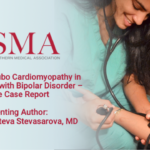Abstract | October 29, 2020
Apical Takotsubo Cardiomyopathy in Young Female with Bipolar Disorder – A Rare Case Report
Learning Objectives
- Takotsubo Cardiomyopathy is not confined to elderly population and can be seen in young female adults.
- Psychiatric conditions seem to be predisposing factor for development of TCM.
- Apical type of TCM is the most prevalent form of TCM with seen in 81.7 percent of patients in the International Takotsubo Registry study.
Introduction: Takotsubo cardiomyopathy (TCM) is a rare condition with incidence of 0.02% [1] of all hospitalizations in the United States and occurs in approximately 1-2% [2] of patients presenting with troponin-positive suspected acute coronary syndrome. TCM is caused primarily by catecholamine excess, microvascular dysfunction, and coronary artery spasm mostly in elderly women with history of smoking, alcohol abuse, anxiety states, and hyperlipidemia. We present a young female with medical history of bipolar disorder who presented with TCM. Prevalence of TCM in young female with bipolar disorder is very scarcely reported in medical literature.
Case report: A 40 year-old Caucasian female was brought in by EMS to ER with substernal chest pain 9/10 intensity, 4.5 hours of duration, associated with nausea and vomiting. She received nitroglycerin and morphine en route. Patient denied any stressors and she did not use inhalers prior to calling EMS. Her Past history is significant for bipolar disorder, Generalized Anxiety disorder, Hypertension, DM, COPD, HLD, Gout, Nicotine dependence. Patient underwent Cardiac catheterization in 2014 and no stents were placed. On presentation her vitals were BP 143/102, HR 124bpm, RR 37, T 98.8F, O2 sat on 2 L nasal cannula 95%. Physical exam did not show heart murmurs, rubs, gallops, friction rub, JVD, carotid bruit, peripheral edema, cyanosis, pulse deficits, no rales, rhonchi or wheezing. Initial evaluation showed ST segment elevations in leads v6, I II, III, AVF and ST depressions in AVR on EKG and elevated troponin, which prompted treatment for STEMI. Cardiac catheterization showed no significant coronary occlusions and left ventriculogram was consistent with a Takotsubo ventricle with reduced ejection fraction of 25%. Follow up Transthoracic Echocardiogram confirmed the diagnosis of TCM. Follow up EKG showed T wave inversions in v3, v4, v5.
Management: Following TCM diagnosis patient was started on Entresto 24/26 mg, Eliquis 5 twice a day, metoprolol ER 25 once a day. Patient is to follow up in 2 weeks with cardiology as outpatient.
References:
- Deshmukh et al, Prevalence of Takotsubo cardiomyopathy in the United States, July 2012, American Heart
Journal - Gianni et al, Apical ballooning syndrome or takotsubo cardiomyopathy: a systematic review, July 2006,
European Heart Journal

